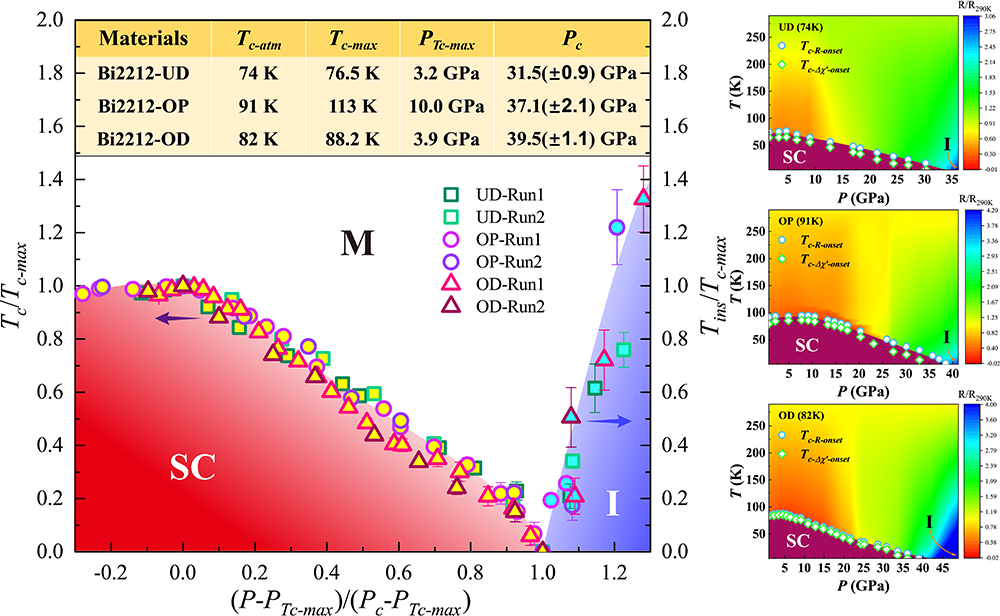Discovery of quantum phase transition in pressurized cuprate superconductors
Date:21-02-2022 Print
The discovery of cuprate high-temperature superconductors in 1986 impacted science and technology considerably and continue to fascinate the communities of condensed matter physics and material sciences because they host the highest ambient-pressure superconducting transition temperature and unconventional electronic behavior. However, the underlying mechanism of the superconductivity is yet an unsolved mystery. Searching for the universal links between the superconducting state and its neighboring quantum states is believed to be an effective approach to elucidate the high temperature superconducting mechanism.
Recently, Prof. Liling Sun's team from Institute of Physics (IOP), Chinese Academy of Sciences, in collaboration with Profs. Tao Xiang, Xingjiang Zhou and Jiangping Hu from IOP, Prof. Genda Gu from Brookhaven National Laboratory and Prof. Cheng-Tian Lin from Max-Planck-Institute, finds the pressure-induced quantum transition from superconducting state to insulating-like state in bismuth-based cuprate superconductors, through their state-of-the-art in-situ high-pressure measurements. These experimental results reveal that the observed quantum phase transition is universal in the bismuth-bearing cuprate superconductors, regardless of the doping level and the number of CuO2 planes in a unit cell.
It is a grand surprise for that the system enters into an insulating-like state after the superconductivity is fully suppressed, because it is well known that the ground state of the over-hole-doped non-superconducting cuprate is a metallic state, and naively one expects that by applying pressure the bandwidth should be increased. As a result, the system should become more metallic, instead of insulating-like. This discovery of the universal quantum transition provides a fresh challenge and a new opportunity for better understanding the mechanism of superconductivity in these materials.
This study entitled "Quantum phase transition from superconducting to insulating-like states in a pressurized cuprate superconductor" has been published on Nature Physics (https://doi.org/10.1038/s41567-022-01513-2).
Drs. Yazhou Zhou, Jing Guo and Shu Cai contributed equally to this work.
The study was supported by the National Science Foundation, the Ministry of Science and Technology of China, the Chinese Academy of Sciences. The high pressure-low temperature XRD measurements were conducted at beamline 4W2 at Beijing Synchrony Radiation Facilities.

Figure 1 Temperature dependence of in-plane resistance for Bi2Sr2CaCu2O8+δ at different pressures. (a) and (d) are the plots of temperature versus resistance with linear and log scales for the under-doped (UD) superconductor; (b) and (e) for the optimally-doped (OP) sample, the two-step superconducting transition demonstrates a crossover from two-dimensional to three-dimensional superconducting phases in the pressure range of 4.9- 23.1 GPa, in good agreements with our previous studies [Nature Physics 16(2020)295]; (c) and (f) for the over-doped (OD) sample.

Figure 2. In-plane resistance (R) and ac susceptibility (Δχ') as a function of temperature (T) for the Bi2Sr2CaCu2O8+δ superconductors at different pressures: (a)-(d) for the under-doped (UD) superconductor; (e)-(h) for the optimally-doped (OP) superconductor; (i)-(l) for the over-doped (OD) superconductor. The blue lines in the figures are the data of Δχ'(T), while the red lines are the data of R(T). The red and blue arrows indicate the temperatures of the onset superconducting transition detected by resistance and ac susceptibility measurements, respectively.

Figure 3 Pressure-Tc phase diagrams for Bi2Sr2CaCu2O8+δ superconductors. The Right panels are the phase diagrams established by the experimental results from the under-doped (UD), optimally-doped (OP) and over-doped (OD) samples, together with the mapping information of temperature and pressure dependent R (shown in color scale). The left panel is a normalized phase diagram that is built on the basis of the experimental phase diagrams (the right panels).
Contact:
Institute of Physics
SUN Liling
Email:llsun@iphy.ac.cn
Key words:
Quantum phase transition, Superconductivity, High pressure
Abstract:
Copper oxide superconductors continue to fascinate the communities of condensed matter physics and material sciences because they host the highest ambient-pressure superconducting transition temperature and unconventional electronic behavior that is not fully explained. Searching for the universal links between the superconducting state and its normal metallic state is believed to be an effective approach to elucidate the underlying mechanism of the superconductivity. One of the common expectations for the copper oxide superconductors is that a metallic phase will present after the superconductivity is entirely suppressed by chemical doping or application of the magnetic field9. Here, we report the first observation of a quantum phase transition from a superconducting state to an insulating-like state as a function of pressure in Bi2Sr2CaCu2O8+δ (Bi2212) superconductors with two CuO2 planes in a unit cell for doping below, at, and above that which gives the highest transition temperature We also find the same phenomenon in related compounds with both one CuO2 plane and three CuO2 planes in a unit cell. This apparently universal phenomenon pose a challenge for achieving unified understandings of the mechanism of the high-temperature superconductivity.


